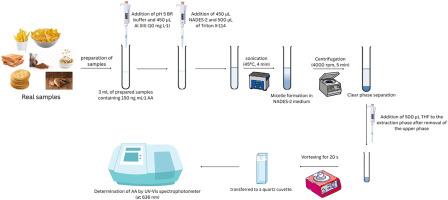基于天然深层共晶溶剂和表面活性剂胶束协同作用的新型绿色可持续溶剂体系,用于分离和测定各种食品中的丙烯酰胺
IF 5.8
2区 化学
Q2 CHEMISTRY, MULTIDISCIPLINARY
引用次数: 0
摘要
本研究介绍了采用表面活性剂调制的天然深共晶溶剂基超声辅助液液微萃取(SM-NADES-SA-LLME)和紫外可见分光光度法(UV-Vis)分离不同食品样品中丙烯酰胺(AA)的分析方法。采用一种新型溶剂体系分离AA,揭示了天然深层共晶溶剂(NADES)与表面活性剂胶束的协同作用。l-脯氨酸是构成蛋白质的20种氨基酸之一,而苹果酸参与克雷布斯循环。使用这些生物来源的成分对于在化学中应用环境可持续性原则和满足绿色分析化学的标准是重要的。NADES (l-脯氨酸:苹果酸)与Triton X-114(非离子表面活性剂)分子之间的相互作用降低了临界胶束浓度,从而快速有效地形成胶束。据我们所知,该溶剂体系首次用于AA的分离。在最佳条件下应用SM-NADES-SA-LLME方法,获得了有效的分析参数。标准物质(crm)也证实了该方法的高准确度。使用特定的软件工具演示了SM-NADES-SA-LLME程序的绿色轮廓和适用性。SM-NADES-SA-LLME方法是一种绿色、选择性、灵敏和准确的分析方法,包括一种新的溶剂体系,用于测定AA。本文章由计算机程序翻译,如有差异,请以英文原文为准。

Novel green and sustainable solvent system based on the synergistic effect of natural deep eutectic solvent and surfactant micelles for the separation and determination of acrylamide from various foodstuffs
The present study introduces the analytical procedure developed for the separation of acrylamide (AA) from different food samples by surfactant-modulated natural deep eutectic solvent-based sonication-assisted liquid-liquid microextraction (SM-NADES-SA-LLME) and subsequent determination by ultraviolet–visible spectrophotometry (UV–Vis). A new solvent system was used for the separation of AA, which reveals the synergistic effect achieved by the combination of natural deep eutectic solvent (NADES) and surfactant micelles. l-proline is one of the 20 amino acids that make up proteins, while malic acid is involved in the Krebs cycle. The use of these components of biological origin is important for the application of environmental sustainability principles in chemistry and for meeting the criteria of Green Analytical Chemistry. The interaction between NADES (l-proline:malic acid) and Triton X-114 (as nonionic surfactant) molecules reduced the critical micelle concentration, resulting in rapid and efficient micelle formation. To the best of our knowledge, this solvent system was used for the first time for the separation of AA. When the SM-NADES-SA-LLME procedure was applied under optimal conditions, efficient analytical parameters were obtained. Certified reference materials (CRMs) have also confirmed the high accuracy of the method. The green profile and applicability of the SM-NADES-SA-LLME procedure were demonstrated using specific software tools. The SM-NADES-SA-LLME procedure comprises a green, selective, sensitive and accurate analytical method including a novel solvent system for the determination of AA.
求助全文
通过发布文献求助,成功后即可免费获取论文全文。
去求助
来源期刊

Sustainable Chemistry and Pharmacy
Environmental Science-Pollution
CiteScore
8.20
自引率
6.70%
发文量
274
审稿时长
37 days
期刊介绍:
Sustainable Chemistry and Pharmacy publishes research that is related to chemistry, pharmacy and sustainability science in a forward oriented manner. It provides a unique forum for the publication of innovative research on the intersection and overlap of chemistry and pharmacy on the one hand and sustainability on the other hand. This includes contributions related to increasing sustainability of chemistry and pharmaceutical science and industries itself as well as their products in relation to the contribution of these to sustainability itself. As an interdisciplinary and transdisciplinary journal it addresses all sustainability related issues along the life cycle of chemical and pharmaceutical products form resource related topics until the end of life of products. This includes not only natural science based approaches and issues but also from humanities, social science and economics as far as they are dealing with sustainability related to chemistry and pharmacy. Sustainable Chemistry and Pharmacy aims at bridging between disciplines as well as developing and developed countries.
 求助内容:
求助内容: 应助结果提醒方式:
应助结果提醒方式:


